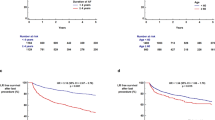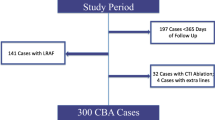Abstract
Background
Performing a cardiac CT scan before ablation provides a better understanding of the anatomical variations of the left atrium and pulmonary veins, as well as an analysis of coronary anatomy and the calcium score. The aim of the present study was to determine whether the CT characteristics of patients with unknown CAD have an impact on recurrence of AF.
Methods
This monocentric retrospective study included patients with AF who had undergone cardiac CT prior to a single ablation.
Results
Among the 229 patients included in the study, 70 (30.5%) presented AF recurrence between 3 and 12 months after a single ablation. The prevalence of CAD confirmed by CT coronary angiogram and the coronary calcium score were similar in the two groups. Patients with recurrent atrial fibrillation had a significantly higher LAVI evaluated by CT scan than patients without recurrence. The ROC curve determined an optimal LAVI threshold of 49 mL/m2. In multivariate analysis, the LAVI measured by CT scan was independently associated with the risk of AF recurrence.
Conclusions
Our study confirms that CAD is not a predictor of AF recurrence after a single ablation, unlike the LAVI. Further studies are necessary to re-evaluate the long-term conclusions of this work.


Similar content being viewed by others
Abbreviations
- ADDs:
-
Antiarrhythmic drugs
- AF:
-
Atrial fibrillation
- ARB II:
-
Angiotensin II receptor antagonist
- BMI:
-
Body mass index
- CAD:
-
Coronary artery disease
- CEI:
-
Converting enzyme inhibitor
- CFAEs:
-
Ablation of complex-fractionated atrial electrograms
- CT:
-
Computed tomography
- Cx:
-
Circumflex artery
- CV:
-
Cardiovascular
- HBP:
-
High blood pressure
- LA:
-
Left atrium
- LAVI:
-
Left atrial volume index
- LVEF:
-
Left ventricular ejection fraction
- LV EDV:
-
Left ventricular end-diastolic volume
- LV ESV:
-
Left ventricular end-systolic volume
- LMCA:
-
Left main coronary artery
- LAD:
-
Left anterior descending
- NOC:
-
New oral anticoagulants
- PAD:
-
Peripheral artery disease
- PVI:
-
Pulmonary venous insulation
- RCA:
-
Right coronary artery
- RF:
-
Radio frequency ablation
- TIA:
-
Transient ischemic attack
- VKA:
-
Vitamin K antagonist
References
Benjamin EJ, Wolf PA, D’Agostino RB, et al. Impact of atrial fibrillation on the risk of death: the Framingham Heart Study. Circulation. 1998;98:946–52.
Zhang H, Yang Y, Zhu J, et al. Baseline characteristics and management of patients with atrial fibrillation/flutter in the emergency department: results of a prospective, multicentre registry in China: atrial fibrillation registry in China. Intern Med J. 2014;44:742–8.
Chiang C-E, Naditch-Brûlé L, Murin J, et al. Distribution and risk profile of paroxysmal, persistent, and permanent atrial fibrillation in routine clinical practice: insight from the real-life global survey evaluating patients with atrial fibrillation international registry. Circ Arrhythm Electrophysiol. 2012;5:632–9.
Meinertz T, Kirch W, Rosin L, et al. Management of atrial fibrillation by primary care physicians in Germany: baseline results of the ATRIUM registry. Clin Res Cardiol. 2011;100:897–905.
Kirchhof P, Benussi S, Kotecha D, et al. 2016 ESC Guidelines for the management of atrial fibrillation developed in collaboration with EACTS. Eur Heart J. 2016;37:2893–962.
Uehara M, Funabashi N, Takaoka H, et al. CHA2DS2-VASc score is a useful-predictor of not prognosis but coronary-arteriosclerosis in chronic atrial-fibrillation compared with CHADS2 score: a two-center study of 320-slice CT, part 2. Int J Cardiol. 2014;177:368–73.
Dogan V, Başaran Ö, Beton O, et al. Coronary artery disease in outpatients with nonvalvular atrial fibrillation: results from the multicenter RAMSES study. Coron Artery Dis. 2016;27:497–503.
Uehara M, Funabashi N, Takaoka H, et al. The CHADS2 score is a useful predictor of coronary arteriosclerosis on 320 slice CT and may correlate with prognosis in subjects with atrial fibrillation. Int J Cardiol. 2015;179:84–9.
Nous FMA, Budde RPJ, van Dijkman ED, et al. Prognostic value of subclinical coronary artery disease in atrial fibrillation patients identified by coronary computed tomography angiography. Am J Cardiol. 2020;126:16–22.
Khoueiry Z, Albenque J-P, Providencia R, et al. Outcomes after cryoablation vs. radiofrequency in patients with paroxysmal atrial fibrillation: impact of pulmonary veins anatomy. Europace. 2016;18:1343–51.
Chao TF, Tsao HM, Lin YJ, et al. Clinical outcome of catheter ablation in patients with nonparoxysmal atrial fibrillation: results of 3-year follow-up. Circ Arrhythm Electrophysiol. 2012;5:514–20.
Calkins H, Hindricks G, Cappato R, Kim YH, Saad EB, Aguinaga L, et al. Document Reviewers 2017. HRS/EHRA/ECAS/APHRS/SOLAECE expert consensus statement on catheter and surgical ablation of atrial fibrillation. Europace. 2018;20(1):e1-160.
Ganesan AN, Shipp NJ, Brooks AG, et al. Long-term outcomes of catheter ablation of atrial fibrillation: a systematic review and meta-analysis. J Am Heart Assoc. 2013;2:e004549.
Piccini JP, Lopes RD, Kong MH, et al. Pulmonary vein isolation for the maintenance of sinus rhythm in patients with atrial fibrillation: a meta-analysis of randomized, controlled trials. Circ Arrhythm Electrophysiol. 2009;2:626–33.
Pathak RK, Middeldorp ME, Lau DH, et al. Aggressive risk factor reduction study for atrial fibrillation and implications for the outcome of ablation. J Am Coll Cardiol. 2014;64:2222–31.
Staerk L, Sherer JA, Ko D, et al. Atrial fibrillation: epidemiology, pathophysiology, and clinical outcomes. Circ Res. 2017;120:1501–17.
Trines SA, Stabile G, Arbelo E, et al. ESC-EHRA Atrial Fibrillation Ablation Long-Term Registry investigators (2019) Influence of risk factors in the ESC-EHRA EORP atrial fibrillation ablation long-term registry. Pacing Clin Electrophysiol. 2019;42:1365–73.
Nedios S, Kosiuk J, Koutalas E, et al. Comparison of left atrial dimensions in CT and echocardiography as predictors of long-term success after catheter ablation of atrial fibrillation. J Interv Card Electrophysiol. 2015;43:237–44.
Ohana M, Bakouboula B, Labani A, et al. Imaging before and after catheter ablation of atrial fibrillation. Diagn Interv Imaging. 2015;96:1113–23.
Zou H, Zhang Y, Tong J, Liu Z. Multidetector computed tomography for detecting left atrial/left atrial appendage thrombus: a meta-analysis: meta-analysis about MDCT detecting LA/LAA thrombi. Intern Med J. 2015;45:1044–53.
Chen LQ, Tsiamtsiouris E, Singh H, et al. Prevalence of coronary artery calcium in patients with atrial fibrillation with and without cardiovascular risk factors. Am J Cardiol. 2020;125:1765–9.
Liu L, Zhao D, Zhang J, et al. Impact of stable coronary artery disease on the efficacy of cryoballoon ablation for the atrial fibrillation. Am J Med Sci. 2019;358:204–11.
Weijs B, Pisters R, Haest RJ, et al. Patients originally diagnosed with idiopathic atrial fibrillation more often suffer from insidious coronary artery disease compared to healthy sinus rhythm controls. Heart Rhythm. 2012;9:1923–9.
Kralev S, Schneider K, Lang S, Süselbeck T, Borggrefe M. Incidence and severity of coronary artery disease in patients with atrial fibrillation undergoing first-time coronary angiography. PLoS One. 2011;6:e24964.
Van Gelder IC, Hagens VE, Bosker HA, et al. A comparison of rate control and rhythm control in patients with recurrent persistent atrial fibrillation. N Engl J Med. 2002;347:1834–40.
Potpara TS, Stankovic GR, Beleslin BD, et al. A 12-year follow-up study of patients with newly-diagnosed lone atrial fibrillation: implications of arrhythmia progression on prognosis: The Belgrade Atrial Fibrillation Study. Chest. 2012;141:339–47.
Zink MD, Chua W, Zeemering S, et al. Predictors of recurrence of atrial fibrillation within the first 3 months after ablation. Europace. 2020;22:1337–44.
Njoku A, Kannabhiran M, Arora R, et al. Left atrial volume predicts atrial fibrillation recurrence after radiofrequency ablation: a meta-analysis. Europace. 2018;20:33–42.
Nedios S, Tang M, Roser M, et al. Characteristic changes of volume and three-dimensional structure of the left atrium in different forms of atrial fibrillation: predictive value after ablative treatment. J Interv Card Electrophysiol. 2011;32:87–94.
Abecasis J, Dourado R, Ferreira A, et al. Left atrial volume calculated by multi-detector computed tomography may predict successful pulmonary vein isolation in catheter ablation of atrial fibrillation. Europace. 2009;11:1289–94.
Kosiuk J, Dinov B, Kornej J, et al. Prospective, multicenter validation of a clinical risk score for left atrial arrhythmogenic substrate based on voltage analysis: DR-FLASH score. Heart Rhythm. 2015;12:2207–12.
Taina M, Korhonen M, Haataja M, et al. Morphological and volumetric analysis of left atrial appendage and left atrium: cardiac computed tomography-based reproducibility assessment. PLoS ONE. 2014;9:e101580.
Maier J, Blessberger H, Nahler A, et al. Cardiac computed tomography-derived left atrial volume index as a predictor of long-term success of cryo-ablation in patients with atrial fibrillation. J Am J Card. 2020;10:061.
Acknowledgements
We would like to thank Mrs. RANKIN Suzanne for her proofreading work.
Author information
Authors and Affiliations
Contributions
Conceptualization: YC, GL, MZ
Data curation: SK, MB, TL, AA, RD, RI
Formal analysis: MM, MZ
Funding acquisition: TL, AC, SS
Investigation: SS, TL, AC, GL, YC
Methodology: MZ, YC
Project administration: MM, MZ, YC
Resources: YC, GL, AC
Software: MM
Supervision: YC, GL
Validation: MZ
Visualization: MM
Writing original draft preparation: SS, YC
Writing—review and editing: MZ, RD, AC, GL
Corresponding author
Ethics declarations
Conflict of interest
YC is a consultant or speaker for Bayer, BMS/Pfizer, Boehringer Ingelheim, Novartis, Sanofi, and Servier. All the other authors declare no competing interests.
Additional information
Publisher’s note
Springer Nature remains neutral with regard to jurisdictional claims in published maps and institutional affiliations.
Rights and permissions
About this article
Cite this article
Sakhy, S., Didier, R., Blain, M. et al. No impact of sub-clinical coronary artery disease identified by cardiac CT scan on the recurrence of atrial fibrillation after a single ablation procedure. J Interv Card Electrophysiol 64, 393–400 (2022). https://doi.org/10.1007/s10840-021-01018-7
Received:
Accepted:
Published:
Issue Date:
DOI: https://doi.org/10.1007/s10840-021-01018-7




